There’s dark immediacy to Micah Zuhl’s heat stroke research. By 2030, it could kill someone working a job approximately every 20 minutes.
Zuhl, part of the School of Health Sciences faculty, hopes to make working in a warming world safer by determining whether nutritional supplements and work breaks done better can save lives.
Heat-related deaths are expected to increase as a warming world creates more extreme temperatures. Hard number estimates are hard to come by, but Zuhl said he read one study that predicted one occupational heat-related death every 14 minutes by 2030.
That, and the human body excels at regulating its core temperature, Zuhl said. It has several different mechanisms by which it can cool itself down.
“Your body is really good at thermal regulating,” he said.
Longer, more extreme heat increases the danger that someone’s core temperature will rise faster than the body’s ability to shut off the heat.
When someone’s body hits 104 degrees Fahrenheit, heat-related illness – called hyperthermia – sets in. The most dangerous form of hyperthermia is heat stroke.
The symptoms – confusion, dizziness, nausea among them – of heat stroke are well known, Zuhl said. Less well-known is what is happening inside someone’s body. Solving that mystery could unlock tools to help workers stay safe in extreme heat.
One leading theory is that heat stroke starts when barriers between the intestinal wall and the rest of the body break down, allowing toxins to flood into the bloodstream, he said.
Shoring up that barrier could prevent that from happening. Part of Zuhl’s research has focused on whether nutritional supplements can help prevent that barrier from failing.
Specifically, he’s used glutamine, a common amino acid the body uses to regulate cell function and growth, to determine whether it can also help that barrier maintain its structural integrity.
Test subjects were given glutamine supplements, then exercised in a specialized hot room. Zuhl and other researchers he’s collaborated with have published papers on the topic previously, and the early results suggest a reason for optimism, he said.
Zuhl is also researching whether taking a better break helps workers recover faster during extreme heat.
Right now, it’s common practice during extreme heat to work for 45 minutes and rest for 15, he said. Zuhl is researching to what degree that recovery is aided by resting in a cool space. That might seem intuitive, but it’s not something anyone has studied in depth.
The human body’s excellent ability to regulate its temperature means it will recover during a break, but if it doesn’t fully recover it creates a cycle by which its core temperature increases to dangerous levels over time.
Volunteers simulated doing manual labor and exercising in a heating room. After 45 minutes, they’ve taken breaks in the same room and one that is cooled. Preliminary data says that resting in a cool space helps the human body cool faster, he said.
Most people who develop heat-related illness can recover if treated promptly, he said. The most important thing is to bring their core temperature down by getting them into a tub of cold water.
But recovery isn’t always complete. Once someone develops heat stroke, their body’s ability to regulate internal temperature can get thrown off permanently. That means preventing heat stroke.
Doing that by providing people with effective supplements and better breaks are important tools, he said.
The most important one is education, he said. That means helping employers understand how to keep their employees safe, coaches keeping their athletes safe and taking care of our most vulnerable.
Developing those tools means understanding what heat stroke does to the body and how to prevent the damage.
It means doing that with 2030 and the prediction of one occupational-related death approximately every 20 minutes looming in the background.





